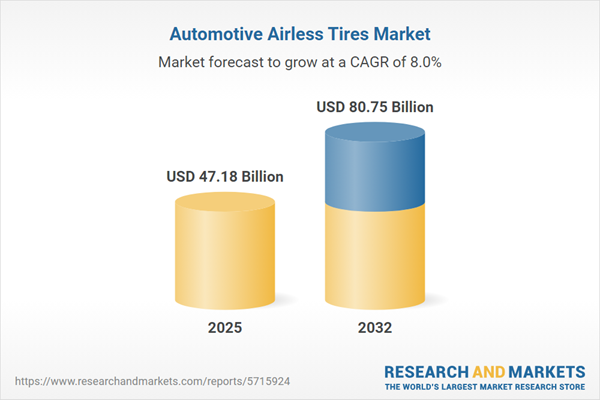Speak directly to the analyst to clarify any post sales queries you may have.
Automotive airless tires are reshaping global mobility strategies for fleet operators and manufacturers, driving advances in operational resilience, maintenance efficiency, and sustainability standards. This report delivers focused insight for senior executives assessing opportunities in an evolving supply and technology landscape.
Market Snapshot: Automotive Airless Tires Market Size and Trends
The global automotive airless tires market reached USD 43.69 billion in 2024, with projections indicating it will grow to USD 47.18 billion by 2025. Analysts forecast a compound annual growth rate (CAGR) of 7.98% through 2032, with the market anticipated to achieve USD 80.75 billion by the end of that period. This robust expansion is largely attributed to broadening adoption across vehicle segments—from commercial fleets to specialized industrial equipment. Increased focus on puncture resistance, minimizing unplanned repairs, and reducing lifecycle costs encourages original equipment manufacturers and operators to advance the integration of airless solutions. Evolving regulatory frameworks and rapid progress in digital and materials technologies continue to set the pace for competitive activity in mature and emerging regions.
Scope & Segmentation: Strategic Analysis of the Automotive Airless Tires Market
This analysis provides senior leaders with a comprehensive breakdown of strategic market segments, enabling data-driven decision-making for competitive advantage:
- Vehicle Types: Explores passenger cars, agricultural machinery, commercial fleets, and industrial vehicles for construction and materials movement, aiding tailored go-to-market strategies across primary end-user groups.
- Off-Road Applications: Evaluates deployment in construction, mining, landscaping, and garden service vehicles to align product development with sector-specific operational demands.
- On-Road Applications: Assesses reliability and continuity advantages for fleets responsible for goods transport and personnel mobility, supporting efficient service delivery.
- Regional Markets: Analyzes opportunities and supply chain considerations in the Americas, Europe, Middle East & Africa, and Asia-Pacific, clarifying each region’s maturity, local demand, and supply dynamics for optimal business positioning.
- Key Market Players: Benchmarks competitive approaches by profiling Michelin, Bridgestone, Goodyear, Continental, Pirelli, Hankook, Sumitomo Rubber Industries, and Resilient Technologies, supporting partner selection and market entry planning.
Each segment is contextualized to highlight growth drivers, operational priorities, and routes to innovation, ensuring strategic actions can be aligned by geography, use case, and technology platform.
Key Takeaways: Strategic Insights for Market Leadership
- Implementing automotive airless tires enhances vehicle uptime and supports fleet productivity by reducing disruptions from unexpected failures and unscheduled stops.
- Adoption of advanced materials and modular, maintenance-friendly tire construction is widening the application scope, enabling service in both high-frequency travel and demanding off-road conditions.
- Integration of digital monitoring solutions delivers real-time data on tire condition, helping operators proactively manage maintenance cycles and optimize asset utilization over time.
- Collaboration between manufacturers, technology providers, and research organizations accelerates advancements in material science and expedites commercial adoption of new tire solutions.
- Locally adapted strategies enhance rollout effectiveness, as regional differences in regulatory requirements and technology acceptance persist—Asia-Pacific markets often lead with faster integration, while North America prioritizes operational reliability and consistency.
- Supply chain resilience is reinforced through sustainable manufacturing initiatives, including the use of recycled content and flexible production methods, advancing both operational and environmental goals.
Tariff Impact: Trade Policy and Supply Chain Adaptation
Forthcoming U.S. tariffs scheduled for 2025 are intensifying global sourcing and procurement complexities in the automotive airless tires industry. As a result, businesses are focusing on domestic and nearshore manufacturing, material diversification, and multilevel supplier collaborations to mitigate risk. Increased coordination with supply chain partners and close engagement with regulators are essential for navigating changes and building robust, policy-resilient business ecosystems.
Methodology & Data Sources
The insights in this report are derived from in-depth secondary research using technical publications and industry white papers, supported by direct interviews with tire manufacturers, materials specialists, and sector end users. Recommendations are further validated by experts in regulatory compliance and engineering to provide a reliable foundation for executive decision-making.
Why This Report Matters: Decision-Ready Intelligence for Leaders
- Empowers executives to evaluate risks and uncover growth opportunities as disruptive influences shape the global landscape for automotive airless tires.
- Supports effective benchmarking and resource deployment across technologies, fleet operations, and priority regions for greater strategic clarity in market positioning.
- Delivers actionable guidance to procurement, R&D, and logistics teams, helping organizations meet objectives and align to new industry standards as they emerge.
Conclusion
Applying the research and recommendations from this report positions senior leaders to drive continuous operational improvement and strategic advancement in the automotive airless tires market. Ongoing, data-informed planning is essential as new technologies and applications transform competitive dynamics.
Additional Product Information:
- Purchase of this report includes 1 year online access with quarterly updates.
- This report can be updated on request. Please contact our Customer Experience team using the Ask a Question widget on our website.
Table of Contents
3. Executive Summary
4. Market Overview
7. Cumulative Impact of Artificial Intelligence 2025
List of Figures
Samples

LOADING...
Companies Mentioned
The key companies profiled in this Automotive Airless Tires market report include:- Compagnie Générale des Établissements Michelin SCA
- Bridgestone Corporation
- The Goodyear Tire & Rubber Company
- Continental AG
- Pirelli & C. S.p.A.
- Hankook Tire & Technology Co., Ltd.
- Sumitomo Rubber Industries, Ltd.
- Resilient Technologies, Inc.
Table Information
| Report Attribute | Details |
|---|---|
| No. of Pages | 190 |
| Published | October 2025 |
| Forecast Period | 2025 - 2032 |
| Estimated Market Value ( USD | $ 47.18 Billion |
| Forecasted Market Value ( USD | $ 80.75 Billion |
| Compound Annual Growth Rate | 7.9% |
| Regions Covered | Global |
| No. of Companies Mentioned | 9 |









